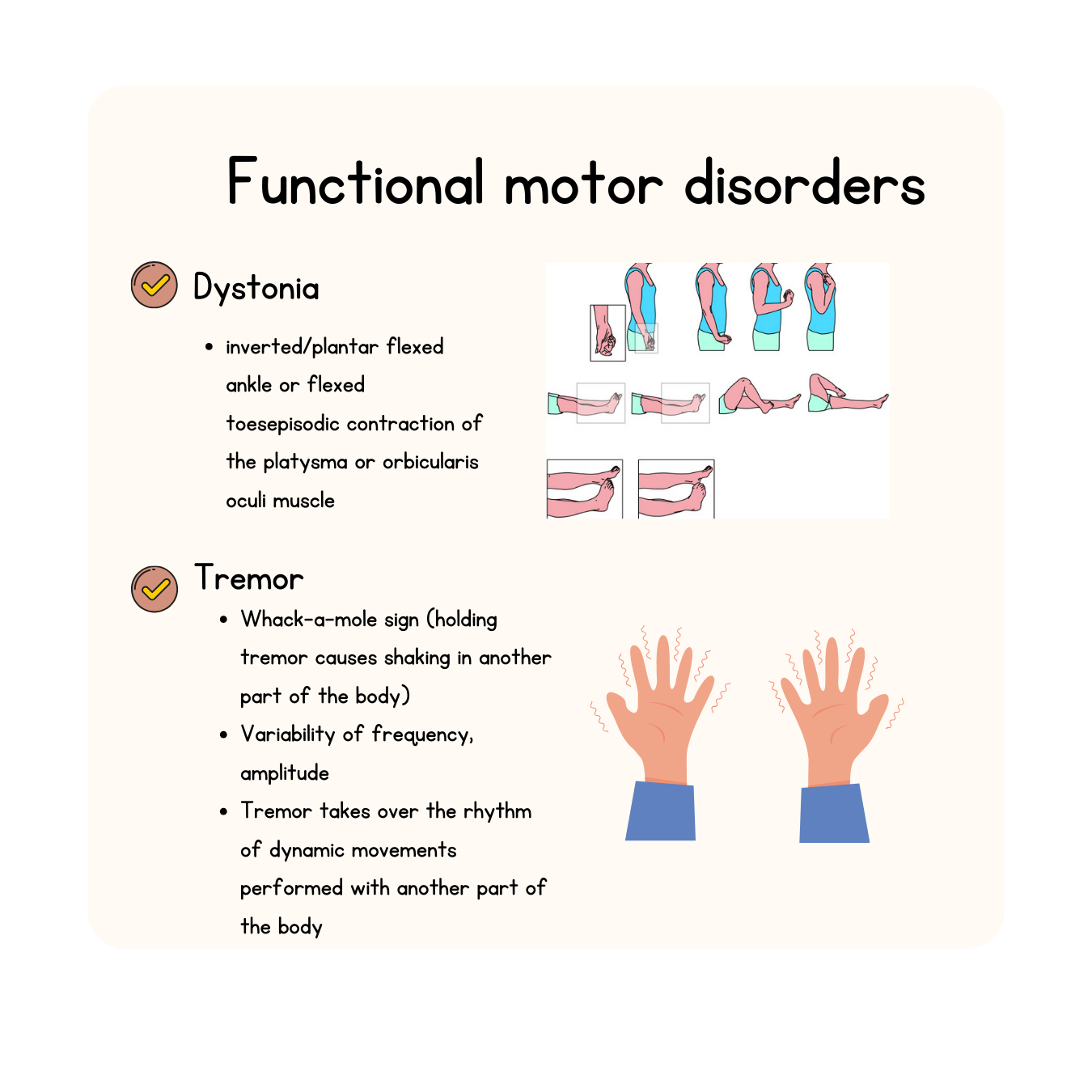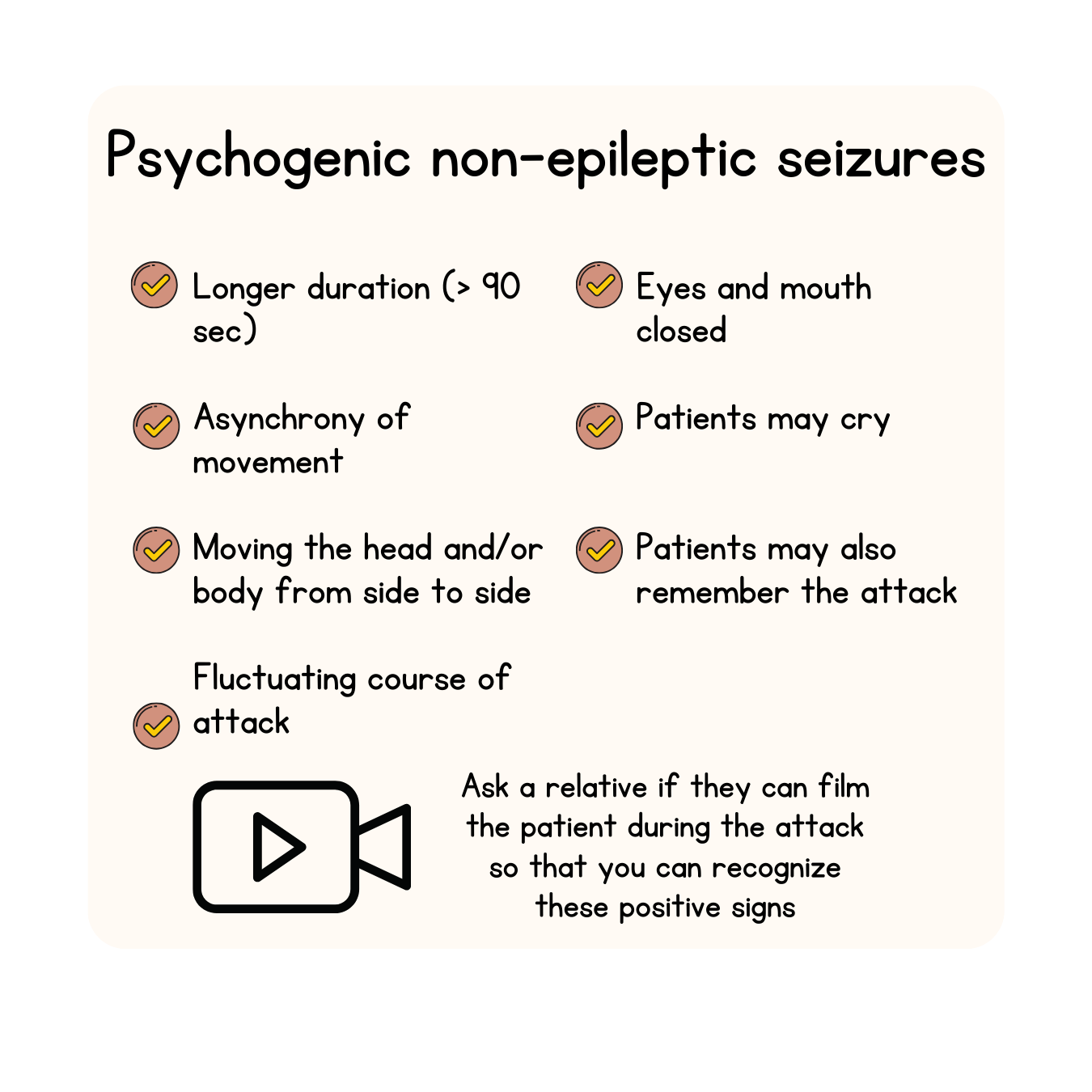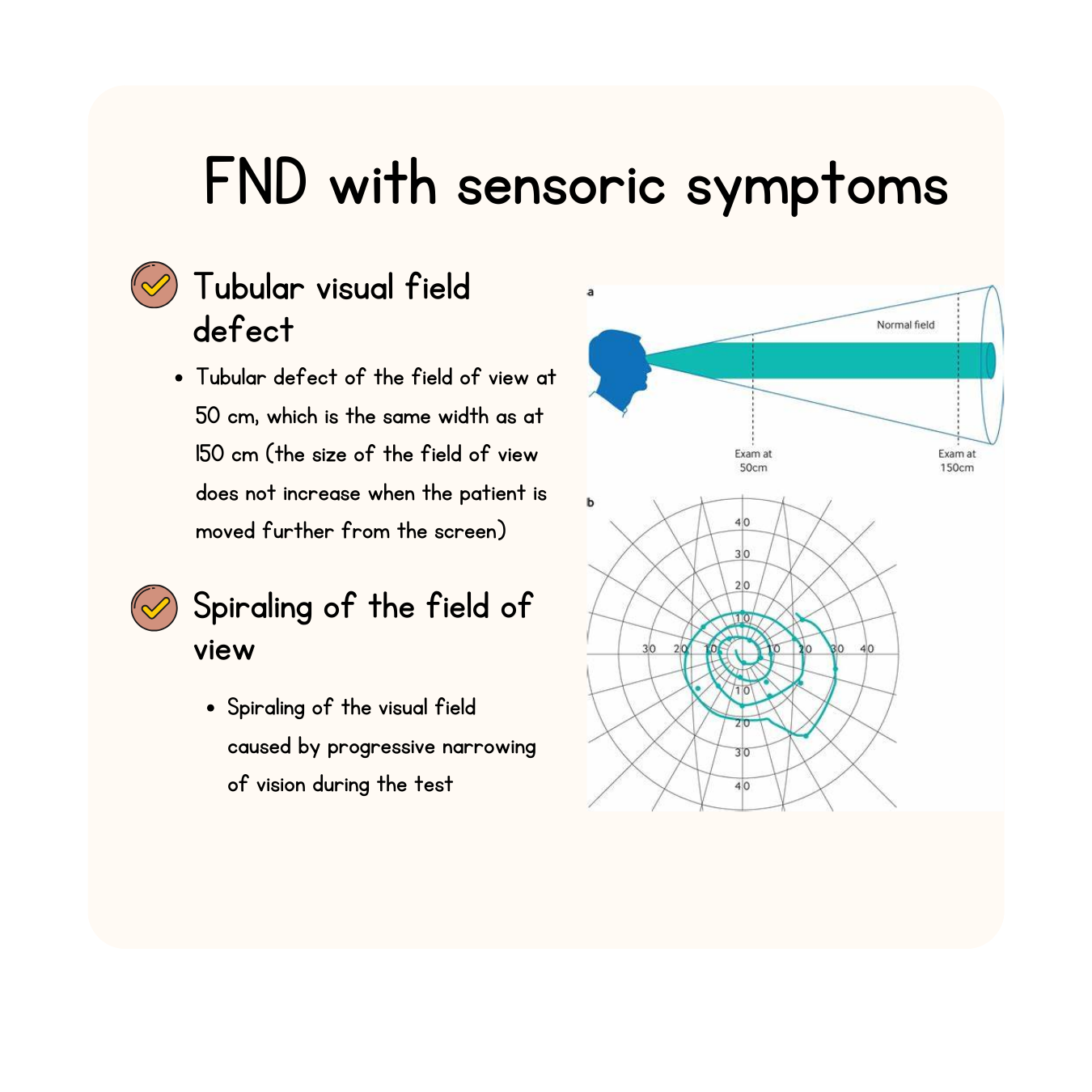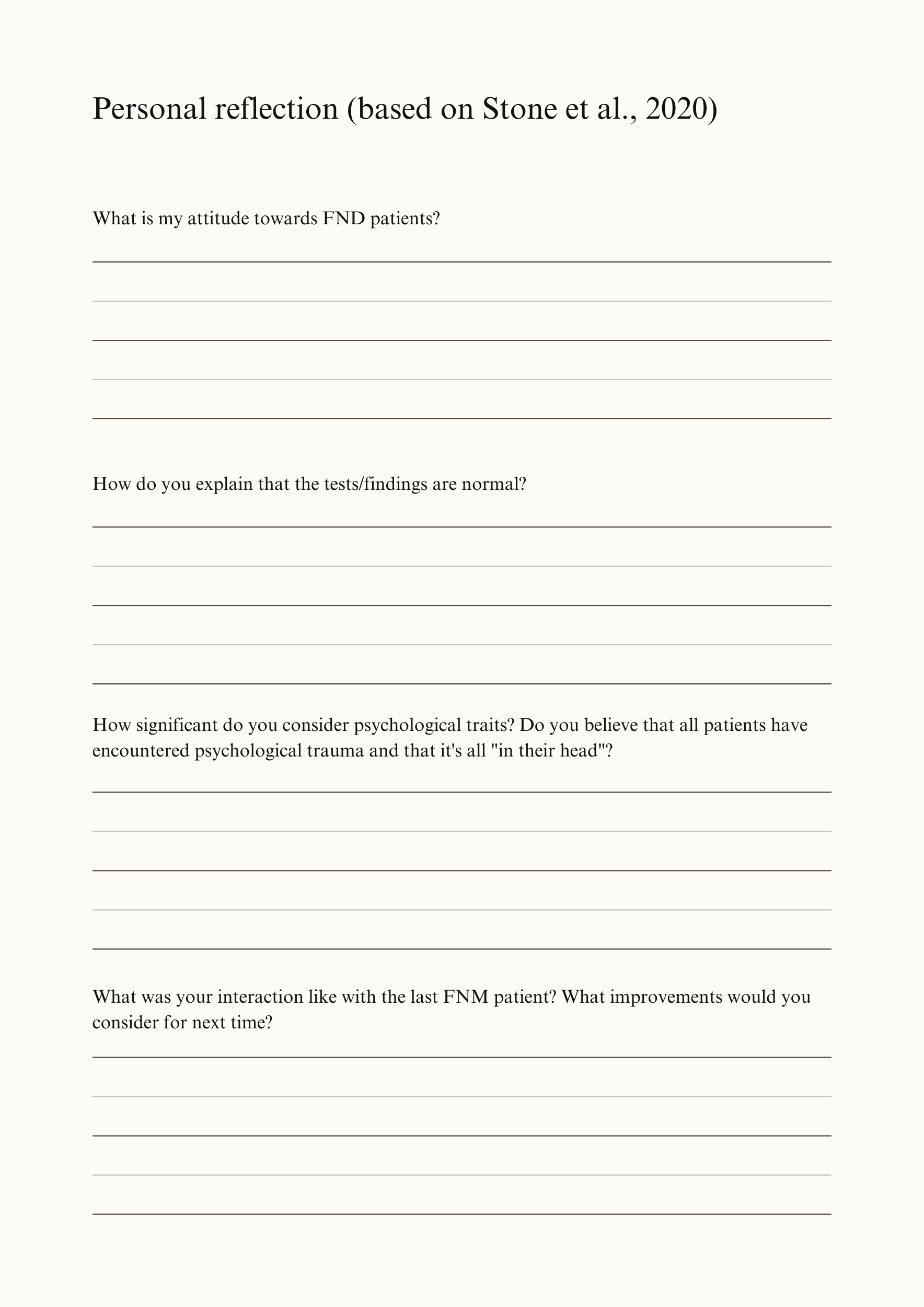Diagnosis
Normalising and correctly communicating a diagnosis can be therapeutic in itself. Communicating FND a diagnosis should be similar to communicating any other neuro(psychological) condition:
give the name of the diagnosis
explain on what basis you diagnosed the patient with this disorder
give some brief information about the disorder and its mechanisms
tell you that the disorder is treatable and that multidisciplinary treatment is optimal
Important cues to consider when communicating your diagnosis:
What terminology to use?
In terms of terminology, it is best to use the term "functional neurological disorder", as it is both aetiologically neutral and the most correct, as it does not imply an absolute psychogenic cause. Show the patient the positive diagnostic signs (described above), as this will show them that the diagnosis has not been made on the basis of excluding other neurological conditions, while at the same time showing them that their condition is potentially reversible (e.g. distraction techniques).
Using analogies. Yes or no?
Analogies such as PC model or software and hardware analogies. Explain to the patient that their hardware is intact, while the software is faulty. If patients are experiencing several different symptoms, you can explain to them that there has been a "software crash" and that one of the goals of treatment is to make an "update in their software system". While the analogy between software and hardware is useful and allows for a better understanding, it is also incomplete as it does not cover all the factors that contribute to the maintenance of the disorder, so it is recommended to complement the explanation with a PC model.
I believe you!
The key is to use language that is non-judgemental, compassionate and makes the patient feel heard and accepted. Emphasise that the symptoms patients are experiencing are real and that they are not imagining them, as this is an important contribution to establishing a trusting therapeutic relationship. Most patients have had negative previous experiences with health professionals, where they have been told that "everything is in their head" and that they are actually simulating their symptoms. At an early stage of diagnosis, it is important to make it clear to the patient that they are certainly not actively and consciously causing their symptoms, but that they are playing an important role in their own recovery. Tell him that he has become your 'co-pilot' and that treatment will only be effective if he takes an active role during the healing process itself (Finkelstein et al., 2022).
Educating and correctly explaining the psychological mechanisms of the disorder
Acceptance and education about the diagnosis itself is one of the most important keys to potential recovery, so getting the diagnosis right is really important! Due to the historical stigma that pervades FND, it is useful to take the time to explain the psychological background of the disorder. The key is not to mistake a risk factor (e.g. psychological trauma or a stressful life event) for a cause, and to explain that there are no separate neurological and psychological patterns in the brain, but that the mind and body are inextricably linked. Psychological factors play an important role, but some patients will not report the need for psychological treatment, so it is important not to push or persuade them, but to confirm that at the next examination they will have the opportunity to clarify any dilemmas about the diagnosis.
An incentive to participate
You can also ask the patient how sure they are of their diagnosis and, if they are not 100% sure, ask them what is 'stopping them'. It is important to encourage honesty and, at the same time, to express unconditional acceptance and empathy, despite potential disagreements. Also encourage the patient to become an active 'co-pilot' by referring them to useful websites with validated information on FND, as they will be empowered by the knowledge and will gain additional insight into their symptoms. The opportunity to see or read stories from other patients can give him a sense of not being alone and satisfy his need to belong and be heard (Finkelstein et al., 2022).
A 28-year-old man gradually develops paralysis and numbness in his left leg after a minor but painful ankle injury. Doctors found no organic cause for the paralysis and he felt rejected, suggesting that it was all in his head. He had a difficult childhood but did not meet the criteria for a diagnosis of clinical depression.
-
There is clear positive evidence of a diagnosis of FND with a pattern of weakness and physical signs including Hoover's sign.
-
Explain that it is a functional neurological disorder.
-
Explain that this is a potentially reversible condition and explain that the hardware is not damaged (hardware; brain) while the software is (software; central nervous system)
-
It is very complicated. Research risk factors at the patient's pace, not yours. Think about how you would explain the cause of a stroke in an ex-smoker or a non-smoker. Do not turn a risk factor into a "cause" of the problem.
-
It is important to consider other investigations, as people with FNM often have other medical conditions that may trigger or increase their vulnerability to the disorder.
-
Physiotherapy can help to re-train the brain so that movements become automatic and normal again. Psychological therapy is useful in terms of understanding why the disorder has developed and how symptoms can be relieved.
-
Adams, C., Anderson, J., Madva, E. N., LaFrance Jr, W. C., in Perez, D. L. (2018). You've made the diagnosis of functional neurological disorder: now what?. Practical neurology, 18(4), 323-330.
Aybek, S., and Perez, D. L. (2022). Diagnosis and management of functional neurological disorder. bmj, 376.
Bennett, K., Diamond, C., Hoeritzauer, I., Gardiner, P., McWhirter, L., Carson, A., and Stone, J. (2021). A practical review of functional neurological disorder (FND) for the general physician. Clinical Medicine, 21(1), 28.
Drane, D. L., Fani, N., Hallett, M., Khalsa, S. S., Perez, D. L., and Roberts, N. A. (2021). A framework for understanding the pathophysiology of functional neurological disorder. CNS Spectrums, 26(6), 555-561.
Espay, A. J., Aybek, S., Carson, A., Edwards, M. J., Goldstein, L. H., Hallett, M., ... in Morgante, F. (2018). Current concepts in diagnosis and treatment of functional neurological disorders. JAMA Neurology, 75(9), 1132-1141.
Finkelstein, S. A., Adams, C., Tuttle, M., Saxena, A., and Perez, D. L. (2022). Neuropsychiatric treatment approaches for functional neurological disorder: a how to guide. In Seminars in Neurology (Vol. 42, No. 02, pp. 204-224). Thieme Medical Publishers, Inc..
Finkelstein, S. A., Cortel-LeBlanc, M. A., Cortel-LeBlanc, A., in Stone, J. (2021). Functional neurological disorder in the emergency department. Academic Emergency Medicine, 28(6), 685-696.
Hallett, M., Aybek, S., Dworetzky, B. A., McWhirter, L., Staab, J. P., in Stone, J. (2022). Functional neurological disorder: new subtypes and shared mechanisms. The Lancet Neurology, 21(6), 537-550.
Stone, J., Burton, C., in Carson, A. (2020). Recognising and explaining functional neurological disorder. bmj, 371.
Stone, J., Carson, A., and Hallett, M. (2016) Explanation as treatment for functional neurological disorders. Handbook of clinical neurology, 139, 543-553.









